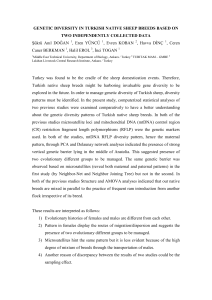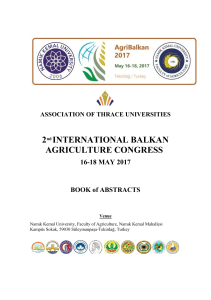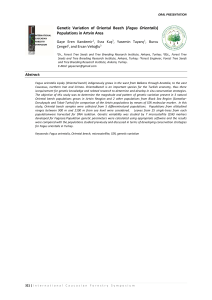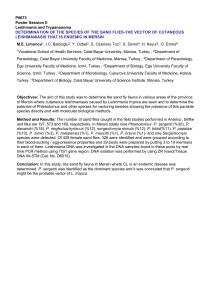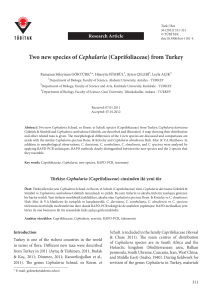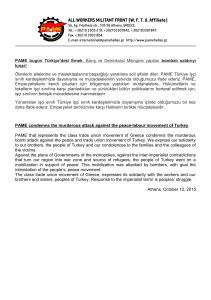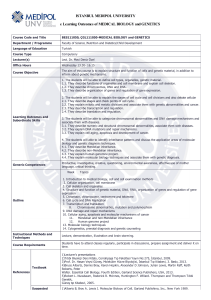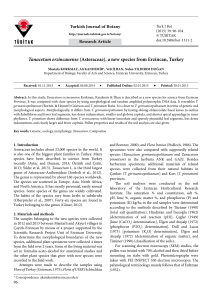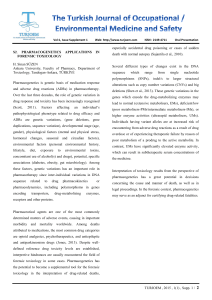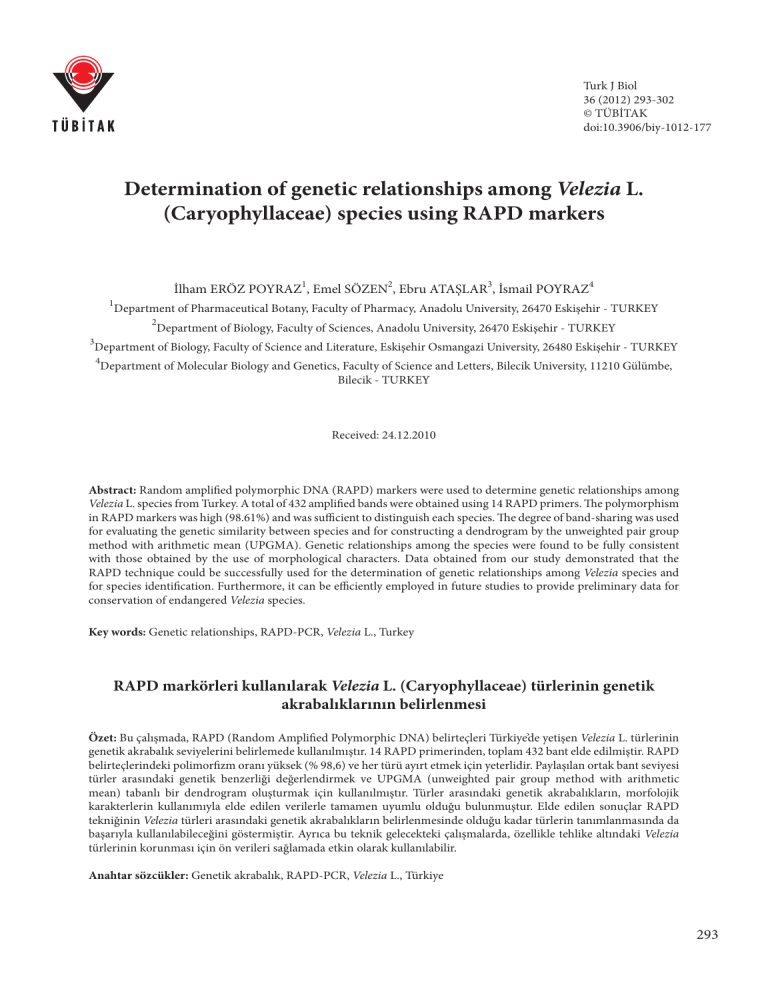
İ. ERÖZ POYRAZ, E. SÖZEN, E. ATAŞLAR, İ. POYRAZ
Turk J Biol
36 (2012) 293-302
© TÜBİTAK
doi:10.3906/biy-1012-177
Determination of genetic relationships among Velezia L.
(Caryophyllaceae) species using RAPD markers
İlham ERÖZ POYRAZ1, Emel SÖZEN2, Ebru ATAŞLAR3, İsmail POYRAZ4
1
Department of Pharmaceutical Botany, Faculty of Pharmacy, Anadolu University, 26470 Eskişehir - TURKEY
2
Department of Biology, Faculty of Sciences, Anadolu University, 26470 Eskişehir - TURKEY
3
Department of Biology, Faculty of Science and Literature, Eskişehir Osmangazi University, 26480 Eskişehir - TURKEY
4
Department of Molecular Biology and Genetics, Faculty of Science and Letters, Bilecik University, 11210 Gülümbe,
Bilecik - TURKEY
Received: 24.12.2010
Abstract: Random amplified polymorphic DNA (RAPD) markers were used to determine genetic relationships among
Velezia L. species from Turkey. A total of 432 amplified bands were obtained using 14 RAPD primers. The polymorphism
in RAPD markers was high (98.61%) and was sufficient to distinguish each species. The degree of band-sharing was used
for evaluating the genetic similarity between species and for constructing a dendrogram by the unweighted pair group
method with arithmetic mean (UPGMA). Genetic relationships among the species were found to be fully consistent
with those obtained by the use of morphological characters. Data obtained from our study demonstrated that the
RAPD technique could be successfully used for the determination of genetic relationships among Velezia species and
for species identification. Furthermore, it can be efficiently employed in future studies to provide preliminary data for
conservation of endangered Velezia species.
Key words: Genetic relationships, RAPD-PCR, Velezia L., Turkey
RAPD markörleri kullanılarak Velezia L. (Caryophyllaceae) türlerinin genetik
akrabalıklarının belirlenmesi
Özet: Bu çalışmada, RAPD (Random Amplified Polymorphic DNA) belirteçleri Türkiye’de yetişen Velezia L. türlerinin
genetik akrabalık seviyelerini belirlemede kullanılmıştır. 14 RAPD primerinden, toplam 432 bant elde edilmiştir. RAPD
belirteçlerindeki polimorfizm oranı yüksek (% 98,6) ve her türü ayırt etmek için yeterlidir. Paylaşılan ortak bant seviyesi
türler arasındaki genetik benzerliği değerlendirmek ve UPGMA (unweighted pair group method with arithmetic
mean) tabanlı bir dendrogram oluşturmak için kullanılmıştır. Türler arasındaki genetik akrabalıkların, morfolojik
karakterlerin kullanımıyla elde edilen verilerle tamamen uyumlu olduğu bulunmuştur. Elde edilen sonuçlar RAPD
tekniğinin Velezia türleri arasındaki genetik akrabalıkların belirlenmesinde olduğu kadar türlerin tanımlanmasında da
başarıyla kullanılabileceğini göstermiştir. Ayrıca bu teknik gelecekteki çalışmalarda, özellikle tehlike altındaki Velezia
türlerinin korunması için ön verileri sağlamada etkin olarak kullanılabilir.
Anahtar sözcükler: Genetik akrabalık, RAPD-PCR, Velezia L., Türkiye
293
Determination of genetic relationships among Velezia L. (Caryophyllaceae) species using RAPD markers
Introduction
In Turkey, the genus Velezia L. (Caryophyllaceae)
comprises 6 species: V. hispida Boiss. & Balansa, V.
quadridentata Sibth. & Sm., V. fasciculata Boiss., V.
rigida L., V. pseudorigida Hub.-Mor., and V. tunicoides
P.H.Davis. Among these, V. rigida is a cosmopolite
species that is widespread in Turkey and throughout
the world; V. quadridentata is mainly distributed over
the northwestern parts of the Marmara and Aegean
regions; V. tunicoides, a narrow, local endemic species,
is distributed only in the Antalya-Göynük region
(southern Turkey); V. hispida, an endemic species,
is distributed only in the middle and southeastern
parts of the Aegean region; and V. pseudorigida is
also an endemic species that is widespread from
the mid-Aegean region to the southwestern parts
of Turkey (1). During the field study, no specimens
for V. fasciculata could be found in the A5 Amasya
and Çorum regions of northern central Turkey. It is
possible that the distribution sites and population
size of this species decreased with time due to
habitat destruction (2). Recently, V. tunicoides and
V. pseudorigida have been categorized as critically
endangered and V. hispida has been categorized as
near threatened (2).
Accurate identification of the species and a precise
diagnostic key are very important for floristic studies;
precise identification also aids in conservation efforts
and the rational use of genetic resources. For this
reason, different types of molecular markers were
developed for facilitating taxonomic, evolutionary,
and phylogenetic studies based solely on morphology
(3-5). As DNA markers are unlimited in number,
produce high polymorphism, and are independent
of environmental interactions, they are considered
valuable tools for determining genetic relationships
and diversity. Random amplified polymorphic DNA
(RAPD) data are known to be generated faster and
more easily than other methods such as restriction
fragment length polymorphism (RFLP) and
microsatellites (6,7). However, the use of RAPD has
been criticized for revealing unreliable phylogenies
owing to the occasional lack of reproducibility and
a possible lack of homology in comigrating bands
(8,9). Despite this limitation, the RAPD method has
been successfully employed in several plant genera
294
for revealing genetic relationships following the
optimization of polymerase chain reaction (PCR)
conditions (3,10-17).
The taxonomy of Velezia is restricted to the
morphological observations made by Davis (1),
and, to date, no study has been undertaken for the
identification and evaluation of genetic relationships
of Velezia based on molecular methods. In Flora of
Turkey, the dichotomous diagnostic key for Velezia
L. was built based on the differences in indumentum,
calyx, petal, and inflorescence. It should be mentioned
that identification of Velezia species solely on the
basis of the morphology of reproductive structures is
very tedious, especially when accurate identification
of 2 morphologically similar species, such as V.
pseudorigida and V. rigida, is undertaken.
Thus, the aim of the present study was to evaluate
the usefulness of the RAPD technique in generating
DNA markers for identifying morphologically
similar Velezia species from Turkey and determining
the genetic relationships among them.
Materials and methods
Plant materials
Whole plant samples from each species of Velezia
were collected at different locations in Turkey (Figure
1, Table 1) between June 2003 and July 2007. Since
V. rigida is a widespread species, 15 populations
from different regions were included in the study.
V. hispida was sampled from 2 localities (B3 Afyon
and C3 Isparta), and Isparta was a new record for V.
hispida. For the other Velezia species, plant samples
were collected from single localities. Samples were
identified based on morphology (Table 1), and
voucher specimens were deposited in the herbarium
of Eskişehir Osmangazi University (OUFE).
DNA extraction
For DNA analysis, 5 plant samples collected from
each locality were used. Total genomic DNA was
extracted from herbarium materials by a modified
hexadecyltrimethyl ammonium bromide (CTAB)
method (18). The quantity and quality of DNA
were determined by using a Nanodrop® ND-1000
spectrophotometer (Wilmington, DE, USA).
İ. ERÖZ POYRAZ, E. SÖZEN, E. ATAŞLAR, İ. POYRAZ
Table 1. The names and locations of Velezia species used for RAPD analyses.
Species
Accessio
no.(OUFE)
Locality and habitat
Altitude
Velezia tunicoides
P.H.Davis
13461
C3 Antalya: Göynük, dry stream bed, 12.07.2007, 36°38ʹ849ʺN, 30°32ʹ962.2ʺE
Velezia hispida Boiss.
13440
B3 Afyon: 2 km to Karakaya village, north hillsides, 24.06.2005, 21.07.2005,
29.07.2006, 02.08.2007, 38°53ʹ19.7ʺN, 30°48ʹ47.8ʺE
1160 m
Velezia hispida Boiss.
13453
C3 Isparta: Gölcük Lake National Park, roadsides, 23.07.2006, 37°43ʹ60ʺN,
30°30ʹE
1200 m
Velezia quadridentata
Sibth. & Sm.
13427
B1 İzmir: Emiralem to Menemen, stony places, 21.05.2005, 38°27ʹ48.7ʺN,
27°12ʹ18.7ʺE
6m
Velezia pseudorigida
Hub.-Mor.
13449
C2 Muğla: Muğla to Yılanlı Forest Management Planning Department, crossroads
of power-plant, southeast, stony-calcareous hillside, 21.07.2006, 37°13ʹ32.1ʺN, 1250-1260 m
26°27ʹ33.0ʺE
Velezia rigida L.
10456
A3 Bilecik: Bozüyük to Bilecik, roadsides, 21.06.2003, 39°54ʹN, 30°2ʹE
873 m
Velezia rigida L.
13415
A3 Bolu: Nallıhan to Mudurnu, 16 km to Mudurnu, roadsides and under
Juniperus sp., 29.07.2004, 40°11ʹ1ʺN, 31°21ʹ2ʺE
1000 m
Velezia rigida L.
13416
A5 Amasya: Eğerli Mountain, north stony hillsides, 28.06.2005, 40°46ʹ41.4ʺN,
35°13ʹ11.3ʺE
910 m
Velezia rigida L.
13419
A5 Amasya: Amasya to Ziyaret, west and east hillsides, roadsides, under Quercus
sp., 06.07.2007, 40°43ʹ30.8ʺN, 35°49ʹ0.20ʺE
720 m
Velezia rigida L.
13420
A5 Çorum: Çorum to Amasya, roadsides, 06.07.2007, 40°35ʹ72.5ʺN, 35°08ʹ61.1ʺE
1026 m
Velezia rigida L.
13464
B1 Çanakkale: 11 km to Ayvacık, 20.05.2005, 39°34ʹ17.7ʺN, 26°32ʹ38.9ʺE
553 m
Velezia rigida L.
13430
B2 Kütahya: Tavşanlı, 28.06.2006, 39°33ʹ07.8ʺN, 29°29ʹ52.7ʺE
938 m
Velezia rigida L.
13431
B2 Kütahya: Tunçbilek, near Ömerler mine, 25.06.2005, 39°40ʹ45.8ʺN,
29°27ʹ10.4ʺE
830 m
Velezia rigida L.
13436
B2 Manisa: Sipil Mountain, west hillsides, 21.05.2005, 38°35ʹ31.2ʺN, 27°26ʹ01.1ʺE
700 m
Velezia rigida L.
13438
B3 Eskişehir: Türkmen Mountain, 28.06.2007, 39°32ʹN, 30°15ʹE
1200 m
Velezia rigida L.
13441
B3 Konya: Akşehir, Tekke village, Sultan Mountains, 13.06.2004, 38°20ʹN,
31°23ʹE
1100 m
Velezia rigida L.
13448
C2 Muğla: Fethiye, Babadağ, parasailing area, 23.06.2005, 36°32ʹ19.9ʺN,
29°10ʹ12.3ʺE
1816 m
Velezia rigida L.
13459
C3 Antalya: Akseki to Sadıklar, road sides, 15.06.2004, 36°57.663ʹN, 31°46.266ʹE
903 m
Velezia rigida L.
13463
C5 Mersin: Gülek-Akçatekir (Tekir), 26.06.2004, 36°55ʹN, 34°53ʹE
1250 m
Velezia rigida L.
13462
C5 Adana: Kozan to Feke 20th km, roadsides in rubble, 25.6.2004, 37°49ʹN,
35°54ʹE
620 m
2m
295
Determination of genetic relationships among Velezia L. (Caryophyllaceae) species using RAPD markers
1
2
3
4
5
6
7
8
9
10
42°
A
40°
B
38°
C
0
26°
28°
30°
32°
34°
36°
38°
10
40°
20
km
42°
36°
44°
Figure 1. Distribution map of Velezia species in Turkey used for RAPD analyses.
DNA samples were diluted to 4 ng/μL, and
bulked DNA samples were prepared by mixing equal
amounts of the 5 representative DNA samples from
each locality. Samples were stored at 4 °C for RAPD
amplification.
RAPD-PCR
RAPD analysis was performed according to the
method of Williams et al. (6). A set of 25 random
10-mer primers was purchased from Thermo Inc.
(Burlington, MA, USA). After screening, 14 primers
that amplified clear, reproducible banding patterns
were used for further analysis (Table 2). PCR
amplifications were performed in 25 μL of reaction
mixture containing 20 ng of template DNA, 1×
Taq polymerase buffer and 1 U of Taq polymerase
(Fermentas, Glen Burnie, MD, USA), 2.0 mM MgCl2,
1 mM dNTP, and 1 μM of primer. Amplifications
were carried out in a Progene Thermal Cycler (Techne
Inc., Burlington, NJ, USA) that was programmed
for the initial denaturation step at 92 °C for 2 min,
followed by 40 cycles of 94 °C for 1 min, 36 °C for
1 min, 72 °C for 2 min, and a final elongation at 72
°C for 7 min. PCR reactions were repeated twice to
ensure reproducibility of amplified products. The
PCR products were separated on a 1.5% agarose
gel containing ethidium bromide (0.5 μg/mL) and
photographed with the UVIpro Gel Documentation
System (UVItec, Cambridge, UK). Molecular weights
of PCR products were estimated using a 100 bp Plus
DNA Ladder (Fermentas). A negative control with no
296
DNA template was also included in the PCR reaction
to check that there was no contamination.
Data analysis
The amplified bands were scored as present (1)
or absent (0). Faintly stained bands that were not
clearly resolved were not considered in the data
collection. Bands with the same migration distance
were considered homologous. The genetic similarity
between all accessions was calculated according to
the Jaccard coefficient (19). The program FreeTree
(20) was used for the construction of an unweighted
pair group method with arithmetic mean (UPGMA)
dendrogram and bootstrap analysis (500 resampled
datasets).
Results
Initially, 25 RAPD primers were screened against
total DNA from 5 Velezia samples: V. tunicoides, V.
hispida, V. quadridentata, V. pseudorigida, and V.
rigida. Based on reproducibility, quality of band
profiles, and level of polymorphism, 14 primers
were selected for the identification of Velezia species
and evaluation of their genetic relationships. These
primers resulted in the amplification of 432 products
of various sizes ranging from 200 bp to 3000 bp (Table
2). RAPD banding patterns using 2 random primers
are represented in Figure 2. The maximum number
of bands, 46, was amplified with primer 23 and the
lowest number, 24, with primer 9. Out of these 432
İ. ERÖZ POYRAZ, E. SÖZEN, E. ATAŞLAR, İ. POYRAZ
Table 2. Details of RAPD banding pattern of 5 species of Velezia using 14 primers.
Name of the
primer
Sequence of the primer
Total number of
bands amplified
Range of
Percentage of polymorphic
amplicons (bp)
bands (PPB %)
P3
5’ GAG GCG GCG A 3’
31
400-1700
100
P5
5’ CTG CGA CGG T 3’
26
300-2000
100
P6
5’ GCG CGG CAG T 3’
33
480-2500
100
P7
5’ TTG CGC CCG G 3’
31
200-3000
96.77
P8
5’ AGA CGC CGA C 3’
27
400-2700
100
P9
5’ GGG AAG AGA G 3’
24
270-2500
100
P11
5’ GGC CGA TGA T 3’
26
400-2700
96.15
P13
5’ ACC GGC TTG T 3’
27
340-2700
100
P14
5’ CAG CAC TGA C 3’
33
300-3000
100
P16
5’ TGG TGG CCT T 3’
34
320-3000
94.11
P17
5’ GTA GCA CTC C 3’
26
400-3000
100
P21
5’ ACG GTG CCT G 3’
27
310-2500
96.26
P23
5’ CGC CCA AGC C 3’
46
470-2750
100
P24
5’ CGC CCT GGT C 3’
41
380-630
97.56
432
200-3000
98.61
Total
Figure 2. RAPD banding patterns in 5 species of Velezia as revealed by primers 5 and 16. M:
GeneRuler 100 bp Ladder Plus, 1-15: Velezia rigida populations, 16: V. pseudorigida
population, 17 and 18: V. hispida populations, 19: V. quadridentata population, 20: V.
tunicoides population, C: control.
297
Determination of genetic relationships among Velezia L. (Caryophyllaceae) species using RAPD markers
amplified bands, 426 were polymorphic and 6 were
monomorphic (Table 2). The highest number of
bands, 153, was amplified in V. rigida, and the lowest,
128, in V. hispida. A unique pattern of amplified
fragments was obtained for each Velezia species.
Some of the fragments were species-specific markers
(Table 3). For example, primer 21 amplified specific
bands that could distinguish all Velezia species.
The similarity matrix was calculated using the
Jaccard similarity coefficient (19) (Table 4). V.
pseudorigida and V. rigida (VR15) showed the highest
similarity (0.63), and the lowest similarity (0.10) was
observed between V. tunicoides and V. pseudorigida.
A wide range of similarity values (0.57-0.89) among
different populations of V. rigida was also observed.
The UPGMA dendrogram showed 2 distinct
clusters (Figure 3). Cluster 1 consisted of 2 subclusters;
the first subcluster included species V. pseudorigida
and V. rigida, and the other subcluster contained
only V. quadridentata. Cluster 2 was also divided
into 2 subclusters; the first subcluster consisted of 2
populations of V. hispida, and the other subcluster
contained V. tunicoides.
Discussion
In this study, the RAPD technique was successfully
utilized to determine the genetic relationships
among the 5 Velezia species collected from different
regions of Turkey. Numerous molecular studies
have been conducted in the family Caryophyllaceae.
For example, the phylogeny of Caryophyllaceae
was studied by using data from the chloroplast
(matK) and nuclear (ITS) regions (21). In another
study, ribosomal internal transcribed spacer (ITS)
sequences and intron sequences of the chloroplast
gene rps16 were used to examine phylogenetic
and biogeographical patterns within the genus
Heliosperma (Sileneae) (22). A phylogenetic study of
the genus Polycarpon was done using DNA sequence
data from the chloroplast rps16 intron and nuclear
RPB2 regions (23). The phylogeny of Moehringia and
its relationship to Arenaria were elucidated using a
broad taxon sampling and by combining molecular and
morphological data (24). Phylogenetic relationships
and the biogeography of the genus Cerastium were
studied using sequences of 3 noncoding plastid DNA
regions: trnL intron, trnL-trnF spacer, and psbA-
Table 3. Selected RAPD markers and their species specific band sizes for 5 Velezia L. species.
V. tunicoides
V. hispida
V. quadridentata
V. pseudorigida
V. rigida
Primer P3
2150 bp
-
250 bp
-
-
Primer P5
730 bp
750 bp, 680 bp, 490 bp, 430 bp
480 bp, 2200 bp
-
-
Primer P6
510 bp, 2700 bp
850 bp, 2300 bp
580 bp,630 bp
620 bp
-
PrimerP7
-
2800 bp
2900 bp
610 bp
-
Primer P8
-
690 bp
-
-
-
Primer P9
-
900 bp, 930 bp, 950 bp
550 bp,400 bp
460 bp
-
Primer P11
-
-
-
290 bp, 820 bp, 2100 bp
-
Primer P13
-
-
640 bp
590 bp
-
Primer P14
290 bp, 910 bp, 1190 bp, 2750 bp
740 bp, 830 bp, 1600 bp
530 bp, 820 bp, 990 bp
750 bp
-
Primer P16
610 bp, 730 bp, 1100 bp
580 bp, 710 bp
-
-
250 bp
Primer P17
480 bp
460 bp, 690 bp, 1190 bp
400 bp
-
-
Primer P21
410 bp, 1490 bp, 2900 bp
460 bp, 480 bp
3000 bp
390 bp, 500 bp
490 bp
Primer P23
490 bp, 530 bp, 685 bp, 760 bp, 980 bp
470 bp, 610 bp, 695 bp, 720 bp
860 bp, 890 bp, 2750 bp
-
-
Primer P24
380 bp
-
630 bp, 840 bp
395 bp
415 bp
298
0.7550
0.7123
0.6500
0.6821
0.5818
0.7351
0.7368
0.7006
0.6987
0.6815
0.6708
0.7215
0.7362
0.5786
0.1379
0.1435
01951
VR3
VR4
VR5
VR6
VR7
VR8
VR9
VR10
VR11
VR12
VR13
VR14
VR15
VPR
VH1
VH2
VQ
01142
0.7655
VR2
VT
1.0000
VR1
VR1
0.1308
0.1854
0.1396
0.1391
0.5860
0.7346
0.7419
0.7006
0.6795
0.7078
0.6772
0.7467
0.7333
0.5793
0.7143
0.6375
0.7589
0.7770
1.0000
--
VR2
0.1205
0.2174
0.1441
0.1387
0.5926
0.7576
0.7117
0.6829
0.6937
0.7000
0.6810
0.7712
0.7355
0.5858
0.7400
0.6228
0.7365
1.0000
--
VR3
0.1346
0.2154
0.1435
0.1378
0.5478
0.7188
0.6604
0.6624
0.6842
0.7020
0.7267
0.7067
0.7162
0.5714
0.7203
0.6516
1.0000
--
VR4
0.1111
0.1896
0.1704
0.1688
0.5298
0.6901
0.6747
0.6768
0.6071
0.6424
0.6446
0.6364
0.6442
0.6481
0.6352
1.0000
--
VR5
0.1215
0.2111
0.1514
0.1404
0.5732
0.7222
0.6962
0.6667
0.6993
0.6839
0.6968
0.6883
0.7086
0.5767
1.0000
--
VR6
0.1382
0.2039
0.1622
0.1659
0.4514
0.6250
0.5988
0.5906
0.6280
0.5858
0.5976
0.6084
0.5964
1.0000
--
VR7
0.1324
0.2146
0.1614
0.1453
0.5644
0.7500
0.7143
0.7170
0.6750
0.7355
0.7152
0.7987
1.0000
--
VR8
0.1261
0.2184
0.1498
0.1392
0.5963
0.7730
0.7484
0.7516
0.7089
0.7829
0.7727
1.0000
--
VR9
0.1295
0.2095
0.1630
0.1519
0.5951
0.7805
0.7785
0.7821
0.7170
0.8146
1.0000
--
VR10
0.1205
0.2057
0.1593
0.1532
0.6025
0.7791
0.7438
0.7580
0.7597
1.0000
--
VR11
0.1161
0.2244
0.1498
0.1392
0.5767
0.7515
0.7267
0.7296
1.0000
--
VR12
0.1333
0.1852
0.1565
0.1506
0.5783
0.7605
0.8993
1.0000
--
VR13
0.1266
0.1881
0.1696
0.1583
0.5964
0.80000
1.0000
--
VR14
0.1398
0.2054
0.1570
0.1514
0.6331
1.0000
--
VR15
0.1075
0.2020
0.1535
0.1577
1.0000
--
VPR
0.2136
0.2010
0.7877
1.0000
--
VH1
0.2111
0.1863
1.0000
--
VH2
0.1969
1.0000
--
VQ
1.0000
--
VT
Table 4. Jaccard similarity coefficients among 5 species of Velezia L. as detected by 14 RAPD primers. VR1: V. rigida (Adana), VR2: V. rigida (Ziyaret-Amasya), VR3: V.
rigida (Antalya), VR4: V. rigida (Manisa), VR5: V. rigida (Bilecik), VR6: V. rigida (Bolu), VR7: V. rigida (Çanakkale), VR8: V. rigida (Çorum-Amasya), VR9: V. rigida
(Eskişehir), VR10: V. rigida (Konya), VR11: V. rigida (Mersin), VR12: V. rigida (Muğla), VR13: V. rigida (Tavşanlı-Kütahya), VR14: V. rigida (Tunçbilek-Kütahya),
VR15: V. rigida (Çitli-Amasya), VPR: V. pseudorigida (Muğla), VH1: V. hispida (Isparta), VH2: V. hispida (Afyon), VQ: V. quadridentata (İzmir), VT: V. tunicoides
(Antalya).
İ. ERÖZ POYRAZ, E. SÖZEN, E. ATAŞLAR, İ. POYRAZ
299
Determination of genetic relationships among Velezia L. (Caryophyllaceae) species using RAPD markers
59%
59%
81%
90%
83%
71%
100%
90%
94%
100%
81%
52%
100%
100%
52%
0.00
0.25
0.50
Coefficient
0.75
VR1
VR2
VR3
VR4
VR6
VR8
VR9
VR10
VR11
VR13
VR14
VR15
VR12
VR5
VR7
VPR
VQ
VH1
VH2
VT
1.00
Figure 3. Dendrogram showing the genetic relationship among 5 species of Velezia
as obtained from UPGMA cluster analysis. VR1: V. rigida (Adana), VR2: V.
rigida (Ziyaret-Amasya), VR3: V. rigida (Antalya), VR4: V. rigida (Manisa),
VR5: V. rigida (Bilecik), VR6: V. rigida (Bolu), VR7: V. rigida (Çanakkale),
VR8: V. rigida (Çorum-Amasya), VR9: V. rigida (Eskişehir), VR10: V.
rigida (Konya), VR11: V. rigida (Mersin), VR12: V. rigida (Muğla), VR13:
V. rigida (Tavşanlı-Kütahya), VR14: V. rigida (Tunçbilek-Kütahya), VR15:
V. rigida (Çitli-Amasya), VPR: V. pseudorigida (Muğla), VH1: V. hispida
(Isparta), VH2: V. hispida (Afyon), VQ: V. quadridentata (İzmir), VT: V.
tunicoides (Antalya).
trnH spacer (25). The phylogenetic relationships
between the 5 dioecious species in Silene section
Melandrium and their putative hermaphrodite
relatives were also investigated based on an extensive
geographic and taxonomic sample, using DNA
sequence data from the chloroplast genome and
the nuclear ribosomal ITS region (26). The genetic
relationships of Dianthus chinensis, D. barbatus, and
D. superbus were studied using sequence-related
amplified polymorphisms (SRAPs) and inter-simple
sequence repeats (ISSRs) and morphological trait
measurements (27). However, as far as we are aware,
no genetic relationship analysis among the Velezia
species has been carried out. The present study,
therefore, is the first molecular research conducted
in the Velezia genus.
In this study, we tested 25 RAPD primers,
and 14 of those primers resulted in satisfactory
amplification patterns with a polymorphism rate
300
of 98.94%. The variations in banding patterns as
well as the total number of bands amplified in
different species (from 128 to 153) indicated that
a considerable degree of polymorphism exists
among species. High polymorphism rates were also
observed among 15 populations of V. rigida and 2
populations of V. hispida. In addition, some of the
amplified fragments were species-specific (Table 3).
Most of the primers tested amplified the bands that
distinguished the morphologically similar V. rigida
and V. pseudorigida. In addition, identification of 5
Velezia species was easily achieved by comparing
the amplified products of primer 21. These results
imply that RAPD markers can provide valuable
information for genetic variation studies undertaken
at intra- and interspecific levels in the genus Velezia.
They may also be useful as taxonomic markers for
facilitating the identification of individuals from
particular Velezia species.
İ. ERÖZ POYRAZ, E. SÖZEN, E. ATAŞLAR, İ. POYRAZ
Recently, RAPD markers were effectively used
to differentiate 2 Cephalaria species, and it was
concluded that RAPD-PCR profiles together
with morphological data provide taxonomic
distinctions at the species level (28). Similarly,
among Caryophyllaceae members, RAPD markers
were successfully used to study genetic relationships
in Silene (29) and to assess intra- and interspecific
genetic diversity levels in Cerastium (30).
The UPGMA dendrogram based on RAPD band
profiles formed 2 clusters, and the closely related
Velezia species shared the same node, justifying their
taxonomical statuses. The first cluster contained
2 subclusters; the first subcluster contained V.
pseudorigida and V. rigida, and the second subcluster
included V. quadridentata. The second cluster
contained V. tunicoides and V. hispida. This grouping
pattern, in general, supports the morphological
findings. The RAPD banding patterns of V. rigida
and V. pseudorigida were quite close, and the highest
genetic similarity (63%) was observed between them.
This finding is not surprising because, as indicated
earlier, these 2 species are morphologically very
similar. The only characteristics that distinguish
these 2 species are their petal shapes and the number
of flowers in inflorescence. In the first cluster, V.
quadridentata was placed in the second subcluster.
This species has coronal scales, as in V. pseudorigida
and V. rigida; however, it also has a glabrous calyx
that serves as the distinctive feature for distinguishing
V. quadridentata from other Velezia species. The
second cluster contained 2 species: V. tunicoides and
V. hispida. These 2 species are endemic to Turkey.
They can be identified from their petal colors and are
morphologically similar in their hispid and tubulate
calyces. In addition, shape, number of costa, and
indumentum of the calyx are the other important
characteristics that distinguish V. tunicoides and V.
hispida from the other Velezia species.
The genus Velezia is represented by 6 species in
Flora of Turkey, of which V. fasciculata Boiss. was
recorded from 2 localities: A5 Amasya and C6 Hatay
(1). During our field study, however, no specimen
of this species could be found in these localities.
Interestingly, several assumed populations were
sampled in the A5 Amasya and Çorum regions.
Subsequent to the morphological studies and the
correction of samples with the voucher specimen
obtained from the herbarium of the Hebrew
University of Jerusalem (HUJ), it was discovered that
the individuals of these populations were V. rigida,
not V. fasciculata. The plant samples taken from these
populations were also included in the RAPD analysis,
and close genetic relationships with other V. rigida
populations were determined. Palaestina is identified
as the distribution area of V. fasciculata according
to HUJ records. This species is reported to be at
risk of extinction in Israel (31). In Turkey, it can be
assumed that since 1967 (last record for the species),
distribution sites and population sizes of this species
may have decreased as a result of habitat destruction.
Hence, intensive excursions in the A5 Amasya and
C6 Hatay regions are necessary to determine the
current status of this species in Turkey.
In conclusion, the present study demonstrated
the usefulness of RAPD markers for the purpose
of identifying species and evaluating the genetic
relationships among Velezia species. These markers
could be further employed in pilot studies concerning
conservation of the 3 endangered Velezia species in
Turkey.
Acknowledgments
The authors would like to thank Prof Dr Avinoam
Danin, Collection Manager of the Hebrew University
of Jerusalem, and Hagar Leschner for providing
V. fasciculata samples from Palaestina. Support
for this study as a project was received from the
Eskişehir Osmangazi University Scientific Research
Projects Commission in the name of “Taxonomical,
Morphological, and Anatomical Investigations on
Petrorhagia (Ser.) Link, Velezia L., and Saponaria L.
Genera in Turkey” (Project Number 200319054).
Corresponding author:
İlham Eröz POYRAZ
Department of Pharmaceutical Botany,
Faculty of Pharmacy,
Anadolu University,
26370 Eskişehir - TURKEY
E-mail: [email protected]
301
Determination of genetic relationships among Velezia L. (Caryophyllaceae) species using RAPD markers
References
1.
Davis PH. Flora of Turkey and the East Aegean Islands.
Edinburgh University Press. Edinburgh; 1967.
18.
Doyle JJ, Doyle JL. Isolation of plant DNA from fresh tissue.
Focus 12: 13-15, 1990.
2.
Poyraz İE. Revision of Genus Velezia L. (Caryophyllaceae)
in Turkey, PhD, Eskişehir Osmangazi University Institute of
Science, 2008.
19.
Jaccard P. Nouvelles recherches sur la distribution florale. Bull
Soc Vaud Nat 44: 223-270, 1908.
20.
3.
Viccini LF, Souza da Costa DC, Machado MA et al. Genetic
diversity among nine species of Lippia (Verbenaceae) based on
RAPD markers. Plant Syst Evol 246: 1-8, 2004.
Hampl V, Pavlícek A, Flegr J. Construction and bootstrap
analysis of DNA fingerprinting-based phylogenetic trees with
a freeware program FreeTree: application to trichomonad
parasites. Int J Syst Evol Micr 51: 731-735, 2001.
4.
Ray T, Roy SC. Phylogenetic relationships between members of
Amaranthaceae and Chenopodiaceae of Lower Gangetic Plains
using RAPD and ISSR markers. Bangladesh J Bot 36: 21-28,
2007.
21.
Fior S, Karis PO, Casazza G et al. Molecular phylogeny of the
Caryophyllaceae (Caryophyllales) inferred from chloroplast
matK and nuclear rDNA ITS sequences. Am J Bot 93: 399-411,
2006.
5.
Bardakçı F. Random amplified polymorphic DNA (RAPD)
markers. Turk J Biol 25: 185-196, 2001.
22.
6.
Williams JGK, Kubelik AR, Livak KJ et al. DNA polymorphisms
amplified by arbitrary primers are useful as genetic markers.
Nucleic Acids Res 18: 6531-6535, 1990.
Frajman B, Eggens F, Oxelman B. Hybrid origins and
homoploid reticulate evolution within Heliosperma (Sileneae,
Caryophyllaceae): a multigene phylogenetic approach with
relative dating. Syst Biol 58: 328-345, 2009.
7.
Hadrys H, Balick M, Schierwater B. Applications of random
amplified polymorphic DNA (RAPD) in molecular ecology.
Mol Ecol 1: 55-63, 1992.
23.
Kool A, Bengtson A, Thulin M. Polyphyly of Polycarpon
(Caryophyllaceae) inferred from DNA sequence data. Taxon
56: 775-782, 2007.
8.
Rieseberg LH. Homology among RAPD fragments in
interspecific comparisons. Mol Ecol 5: 99-105, 1996.
24.
9.
Bachmann K. Nuclear DNA markers in plant biosystematic
research. Opera Bot 132: 137-148, 1997.
Fior S, Karis PO. Phylogeny, evolution, and systematics of
Moehringia (Caryophyllaceae) as inferred from molecular
and morphological data: a case of homology reassessment.
Cladistics 23: 362-372, 2007.
10.
Açık L, Ekici M, Çelebi A. Taxonomic relationships in
Astragalus sections Hololeuce and Synochreati (Fabaceae):
evidence from RAPD-PCR and SDS-PAGE of seed proteins.
Ann Bot Fenn 41: 305-317, 2004.
25.
Scheen AC, Brochmann C, Brysting AK et al. Northern
hemisphere biogeography of Cerastium (Caryophyllaceae):
insights from phylogenetic analysis of noncoding
plastidnucleotide sequences. Am J Bot 91: 943-952, 2004.
11.
Goh MWK, Kumar PP, Lim SH et al. Random amplified
polymorphic DNA analysis of the moth orchids, Phalaenopsis
(Epidendroideae: Orchidaceae). Euphytica 141: 11-22, 2005.
26.
Rautenberg A, Hathaway L, Oxelman B et al. Geographic
and phylogenetic patterns in Silene section Melandrium
(Caryophyllaceae) as inferred from chloroplast and nuclear
DNA sequences. Mol Phylogenet Evol 57: 978-991, 2010.
12.
Mattagajasingh I, Mukherjeea AK, Dasa P. Genomic relations
among 31 species of Mammillaria Haworth (Cactaceae) using
random amplified polymorphic DNA. Z Naturforsch 61c: 583591, 2006.
27.
13.
Chaudhary LB, Rana TS, Narzary D et al. A new species
of Astragalus L. (Leguminosae) from India based on
morphological and molecular markers. Bot J Linn Soc 154: 2734, 2007.
Fu XP, Ning GG, Gao LP et al. Genetic diversity of Dianthus
accessions as assessed using 2 molecular marker systems
(SRAPs and ISSRs) and morphological traits. Sci Hortic 117:
263-270, 2008.
28.
Aksoy N, Göktürk S, Açık L et al. Cephalaria duzceënsis
(Dipsacaceae), a new species from the western Black Sea
region, Turkey. Nordic J Bot 25: 64-69, 2007.
29.
Sheidai M, Gholipou A, Noormohammadi Z. Species
relationship in the genus Silene L. section Auriculatae
(Caryophyllaceae) based on morphology and RAPD analyses.
Acta Biol Szeged 54: 25-31, 2010.
30.
Maki M, Horie S. Random amplified polymorphic DNA
(RAPD) markers reveal less genetic variation in the
endangered plant Cerastium fischerianum var. molle than in
the widespread conspecific C. fischerianum var. fischerianum
(Caryophyllaceae). Mol Ecol 8: 145-150, 1999.
31.
Sapir Y, Shmida A, Fragman O. Constructing Red Numbers
for setting conservation priorities of endangered plant species:
Israeli flora as a test case. J Nat Conserv 11: 91-107, 2003.
14.
Pendleton RL, Kitchen SG, Mudge J et al. Origin of the flax
cultivar ‘Appar’ and its position within the Linum perene
complex. Int J Plant Sci 169: 445-453, 2008.
15.
Çelebi A, Açık L, Aytaç Z. Biosystematics studies among
Ebenus L. species based on morphological, RAPD-PCR, and
seed protein analyses in Turkey. Pak J Bot 41: 2477-2486, 2009.
16.
Mahmood T, Muhammad S, Shinwari ZK. Molecular and
morphological characterization of Caralluma species. Pak J
Bot 42: 1163-1171, 2010.
17.
Aliyev RT, Abbasov MA, Mammadow AC. Genetic
identification of diploid and tetraploid wheat species with
RAPD markers. Turk J Biol 31: 173-180, 2007.
302

